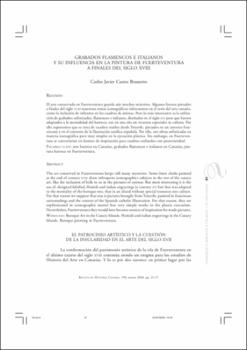Grabados flamencos e italianos y su influencia en la pintura de Fuerteventura a finales del siglo XVIII
Fecha
2008Resumen
El arte conservado en Fuerteventura guarda aún muchos misterios. Algunos lienzos pintados
a finales del siglo XVIII muestran temas iconográficos infrecuentes en el resto del arte canario,
como la inclusión de infiernos en los cuadros de ánimas. Pero lo más interesante es la utilización
de grabados sofisticados, flamencos e italianos, diseñados en el siglo XVI pero que fueron
adaptados a la mentalidad del barroco, eso en una isla sin recursos especiales ni cultura. Por
ello suponemos que se trata de cuadros traídos desde Tenerife, pintados en un entorno franciscano
y en el contexto de la Ilustración católica española. Por ello, son obras sofisticadas en
materia iconográfica pero muy simples en la ejecución plástica. Sin embargo, en Fuerteventura
se convertirían en fuentes de inspiración para cuadros realizados con posterioridad. The art conserved in Fuerteventura keeps still many mysteries. Some linen cloths painted
at the end of century XVIII show infrequent iconographics subjects in the rest of the canary
art, like the inclusion of hells to us in the pictures of animae. But most interesting it is the
use of, designed falsified, flemish and italian engravings in century XVI but that was adapted
to the mentality of the baroque one, that in an island without special resources nor culture.
For that reason we suppose that one is pictures brought from Tenerife, painted in franciscan
surroundings and the context of the Spanish catholic Illustration. For that reason, they are
sophisticated in iconographic matter but very simple works in the plastic execution.
Nevertheless, Fuerteventura they would later become sources of inspiration for made pictures.






